A tight housing supply will continue to drive strong demand for this company

Even as prices have moderated, demand for lumber is still around all-time highs as a shortage of homes for sale persists, and this company should continue to see its business surge higher in 2021.
Yet, rating agencies still rate its debt as high risk, which seems rather pessimistic given its strong fundamentals.
Also below, the company’s Uniform Accounting Performance and Valuation Tearsheet.
Investor Essentials Daily:
Wednesday Tearsheets
Powered by Valens Research
We’ve had a running joke here at Valens over the past few months that the gold crowd has hitched itself to the wrong investment horse.
Instead of buying gold as an inflation hedge all these years, what they should have been buying is lumber, whose price – despite its recent decline from extraordinary levels – has risen exponentially higher than that of gold.
This comes as demand for buildings, particularly houses, has gone (pun intended) through the roof.
For companies like Boise Cascade (BCC), which manufactures and distributes wood products and building materials, this construction boom has resulted in robust sales growth and expanded profitability over the past year or so.
And based on current housing market conditions of sky-high demand and all-time low inventories, BCC appears well positioned for inevitable construction in the years to come.
Yet, major ratings agencies view the company’s debt as highly speculative, notwithstanding its favorable economic position.
The ratings agency Moody’s rates BCC as a non-investment grade Ba3 credit, implying a 10%+ risk of default over the next five years.
Relying on the major Wall Street ratings firms, investors are led to believe Boise Cascade is on the brink of default.
Here at Valens however, we see things a bit differently.
Our Credit Cash Flow Prime (CCFP) analysis is able to get to the heart of the firm’s true credit risk.
In the chart below, the stacked bars represent the firm’s obligations each year for the next five years. These obligations are then compared to the firm’s cash flow (blue line) as well as the cash on hand available at the beginning of each period (blue dots) and available cash and undrawn revolver (blue triangles).
As depicted, Boise Cascade has ample cash liquidity and therefore should have no difficulty meetings its future obligations. Moreover, even if the firm lost access to this capital, cash flows alone are projected to exceed all obligations by a wide margin through 2027.
Rather than a distressed credit, BCC is actually in a quite comfortable cash position. This is why Moody’s Ba3 non-investment grade speculative rating, with a 10+% risk of default expectation, does not make much sense.
Using the CCFP analysis, Valens rates Boise Cascade as an investment grade IG4+. This rating corresponds with an expected default rate below 2% within the next five years, a more realistic projection once a holistic understanding of the company’s risk is taken into account.
Ultimately, Uniform Accounting and the Credit Cash Flow Prime analysis highlight how Boise Cascade’s credit risk profile is much safer than what rating agencies believe, especially when considering the tailwinds the company enjoys from the tight housing supply.
SUMMARY and Boise Cascade Company Tearsheet
As the Uniform Accounting tearsheet for Boise Cascade Company (BCC:USA) highlights, the Uniform P/E trades at 6.2x, which is below the global corporate average of 23.7x, and its historical average of 9.0x.
Low P/Es require low EPS growth to sustain them. That said, in the case of Boise Cascade, the company has recently shown a 162% Uniform EPS growth.
Wall Street analysts provide stock and valuation recommendations that in general provide very poor guidance or insight. However, Wall Street analysts’ near-term earnings forecasts tend to have relevant information.
We take Wall Street forecasts for GAAP earnings and convert them to Uniform earnings forecasts. When we do this, Boise Cascade’s Wall Street analyst-driven forecast is a 169% EPS growth in 2021 and a 56% shrinkage in 2022.
Based on the current stock market valuations, we can use earnings growth valuation metrics to back into the required growth rate to justify Boise Cascade’s $58.62 stock price. These are often referred to as market embedded expectations.
The company is currently being valued as if Uniform earnings were to shrink 10% annually over the next three years. What Wall Street analysts expect for Boise Cascade’s earnings growth is well above what the current stock market valuation requires in 2021, but below this requirement in 2022.
Furthermore, the company’s earning power is 2x the corporate average. Also, cash flows and cash on hand are 6x above its total obligations—including debt maturities, and capex maintenance. This signals a low credit and dividend risk.
To conclude, Boise Cascade’s Uniform earnings growth is above its peer averages, while the company is trading below average peer valuations.
Best regards,
Joel Litman & Rob Spivey
Chief Investment Strategist &
Director of Research
at Valens Research





